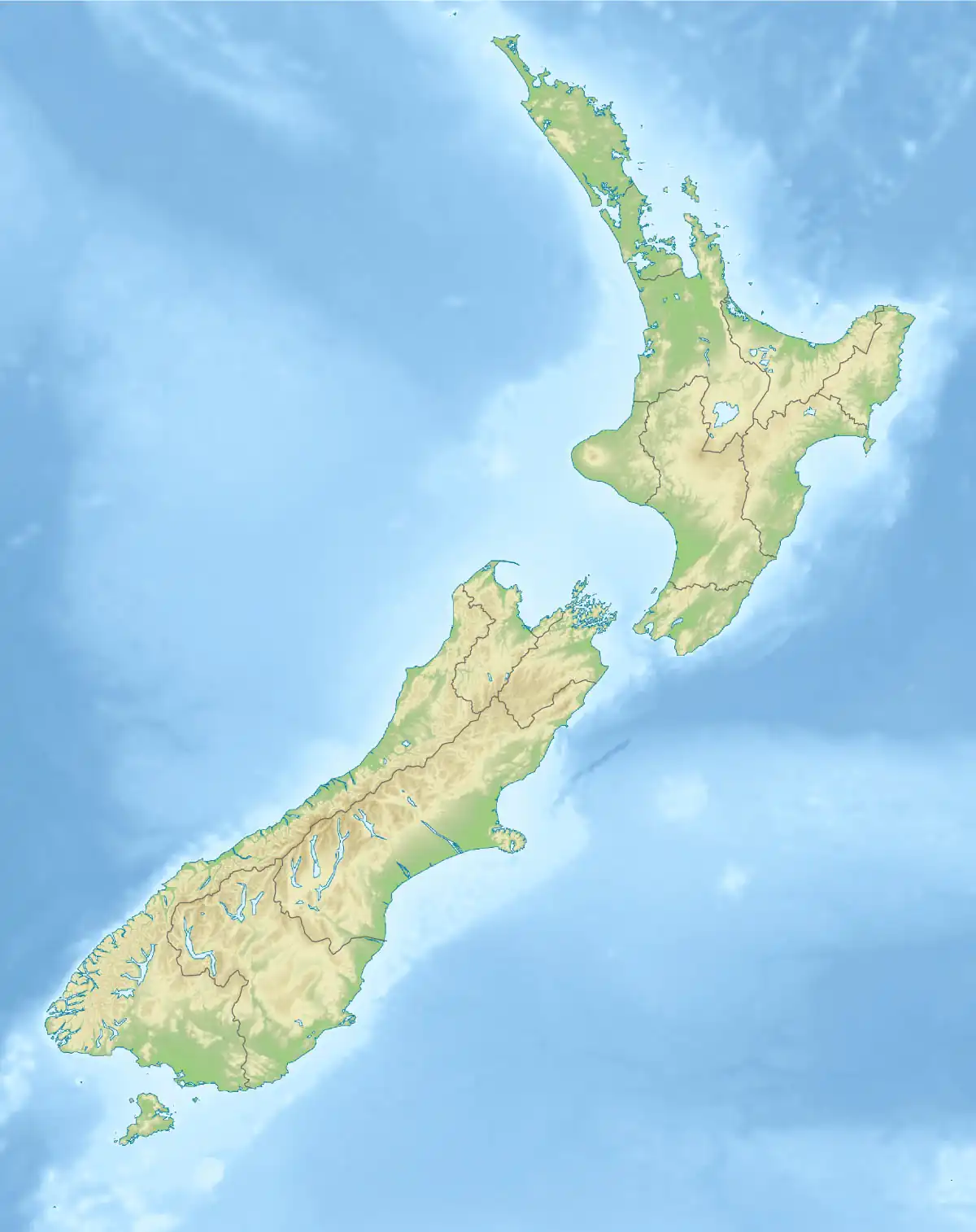| Kokoamu Greensand | |
|---|---|
| Stratigraphic range: Chattian ~ | |
| Type | Geological formation |
| Unit of | Otiake Group |
| Underlies | Otekaike Limestone |
| Overlies | Earthquakes Marl |
| Thickness | up to 7 metres (20 ft) |
| Lithology | |
| Primary | Greensand |
| Other | Limestone |
| Location | |
| Coordinates | 44°42′S 170°30′E / 44.7°S 170.5°E |
| Approximate paleocoordinates | 50°30′S 176°18′W / 50.5°S 176.3°W |
| Region | Canterbury, Otago |
| Country | New Zealand |
| Extent | Around Duntroon, South Island |
 Kokoamu Greensand (New Zealand) | |
The Kokoamu Greensand is a geological formation found in New Zealand. It is a fossil-bearing, late Oligocene, greensand rock unit of the eastern South Island, especially the Waitaki District of North Otago and the southern Canterbury region. The formation was named by geologist Maxwell Gage in the 1950s. In North Otago it underlies the thicker and harder Otekaike Limestone.[1] The formation gets its green colour from the mineral glauconite which forms slowly on the ocean floor.
Fossil content
The formation was laid down in shallow seas some 26-30 million years ago. It contains abundant microfossils of foraminifera, ostracods and coccoliths, those of larger marine invertebrates such as the shells of brachiopods, gastropods and scallops, as well as corals, echinoderms, and crustaceans. Vertebrates found in the formation include fish, penguins and cetaceans. Many of the fossils discovered in the formation are held in the Geology Museum of the University of Otago.[1]
- Penguins
- Archaeospheniscus lopdelli, A. lowei[2][3]
- Duntroonornis parvus[3]
- Kairuku waitaki, K. grebneffi, K. waewaeroa[4][5]
- Korora oliveri[6]
- Manu antiquus[3]
- Palaeeudyptes[3]
- Platydyptes amiesi, P. marplesi, P. novaezealandiae[6][3]
- Cetaceans
See also
References
- 1 2 Fordyce, R. Ewan. "The Kokoamu Greensand – Late Oligocene, New Zealand". Geological Settings. Department of Geology, University of Otago. Retrieved 2012-02-29.
- ↑ Maerewhenua at Fossilworks.org
- 1 2 3 4 5 6 7 Duntroon at Fossilworks.org
- ↑ J40/f190 - Waihao River at Fossilworks.org
- ↑ Waipati Creek at Fossilworks.org
- 1 2 Hakataramea Valley at Fossilworks.org
- ↑ Tanaka, Yoshihiro; Fordyce, R. Ewan (2017). "Awamokoa tokarahi, a new basal dolphin in the Platanistoidea (late Oligocene, New Zealand)" (PDF). Journal of Systematic Palaeontology. 15 (5): 365–386. doi:10.1080/14772019.2016.1202339. Retrieved 18 January 2023.
- ↑ Haughs Quarry at Fossilworks.org
- ↑ J40/f70 - Waihao River at Fossilworks.org
- ↑ The Earthquakes at Fossilworks.org
Further reading
- R. W. Boessenecker and R. E. Fordyce. 2016. A new eomysticetid from the Oligocene Kokoamu Greensand of New Zealand and a review of the Eomysticetidae (Mammalia, Cetacea). Journal of Systematic Palaeontology
- R. E. Fordyce. 2002. Oligocene origins of skim-feeding right whales: A small archaic balaenid from New Zealand. Journal of Vertebrate Paleontology 22(3):54A
- D. T. Ksepka, R. E. Fordyce, T. Ando and C. M. Jones. 2012. New fossil penguins (Aves, Sphenisciformes) from the Oligocene of New Zealand reveal the skeletal plan of stem penguins. Journal of Vertebrate Paleontology 32(2):235-254
- D. MacKinnon, S. S. Beus, and D.L. Lee. 1993. Brachiopod fauna of the Kokoamu Greensand (Oligocene), New Zealand. New Zealand Journal of Geology and Geophysics 36:327-347
- B. J. Marples. 1956. Cetotheres (Cetacea) from the Oligocene of New Zealand. Proceedings of the Zoological Society of London 126(4):565-580
- Y. Tanaka and R. E. Fordyce. 2016. Awamokoa tokarahi, a new basal dolphin in the Platanistoidea (late Oligocene, New Zealand). Journal of Systematic Palaeontology
- C. H. Tsai and R. E. Fordyce. 2016. Archaic baleen whale from the Kokoamu Greensand: earbones distinguish a new late Oligocene mysticete (Cetacea: Mysticeti) from New Zealand. Journal of the Royal Society of New Zealand